Tata Nano: Ethical Leadership, Affordable Car, and Challenges Report
VerifiedAdded on 2022/08/26
|6
|1381
|16
Report
AI Summary
This report provides an in-depth analysis of the Tata Nano, focusing on the ethical leadership principles demonstrated by Tata Motors, particularly under the guidance of Ratan Tata. It examines the company's initiative to create an affordable car for the middle-class families in India, highlighting the design, features, and the strategic intent behind the Nano. The report delves into the application of ethical leadership, emphasizing fairness, trust, and honesty within the organizational structure. It also addresses the challenges faced by Tata Motors, including production site issues, political hurdles, and market dynamics. The report concludes by discussing the potential for Tata Motors to expand its business in emerging markets and the importance of ethical leadership in achieving its goals. It also references the company's strategic decisions, production constraints, and the impact of market competition.
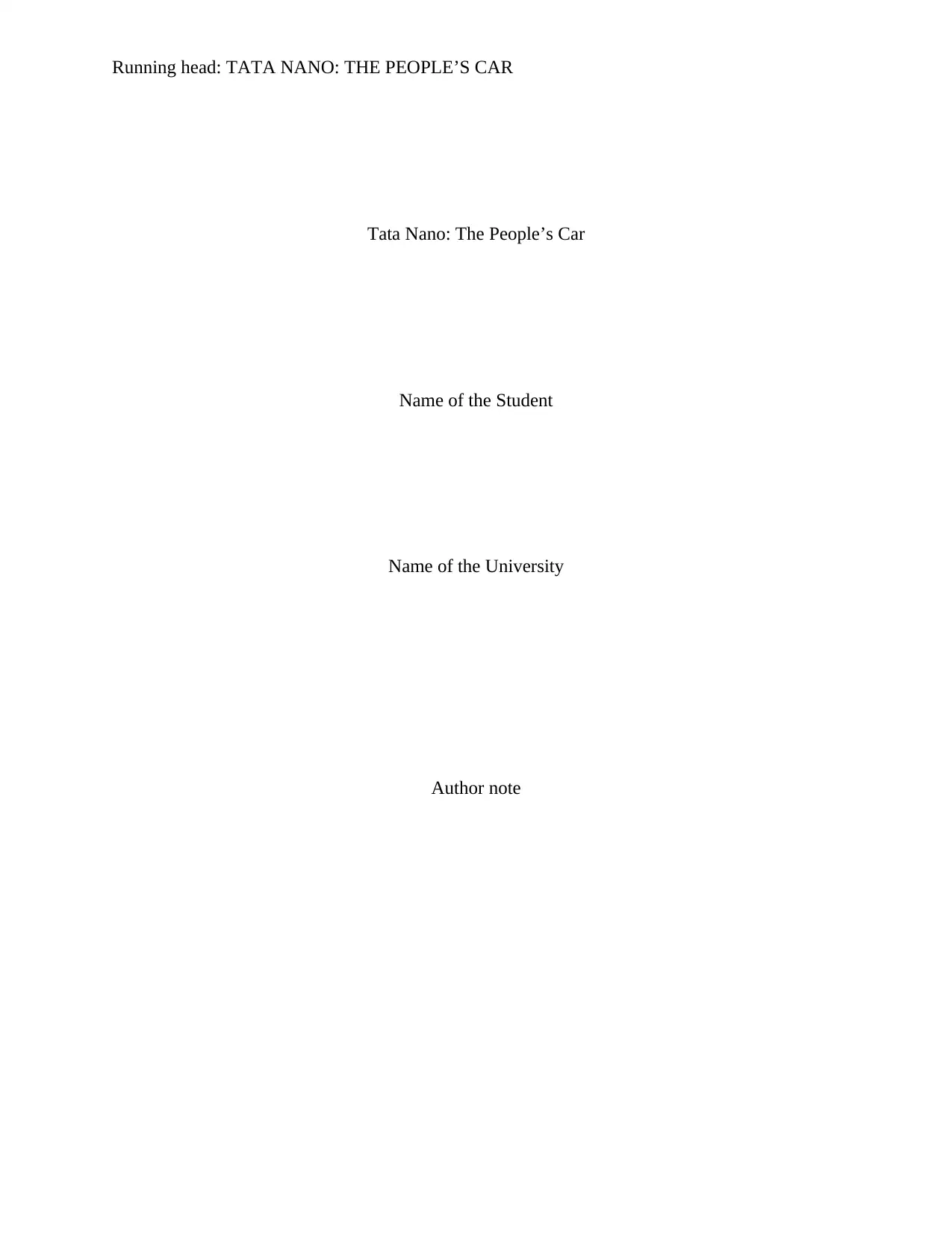
Running head: TATA NANO: THE PEOPLE’S CAR
Tata Nano: The People’s Car
Name of the Student
Name of the University
Author note
Tata Nano: The People’s Car
Name of the Student
Name of the University
Author note
Paraphrase This Document
Need a fresh take? Get an instant paraphrase of this document with our AI Paraphraser
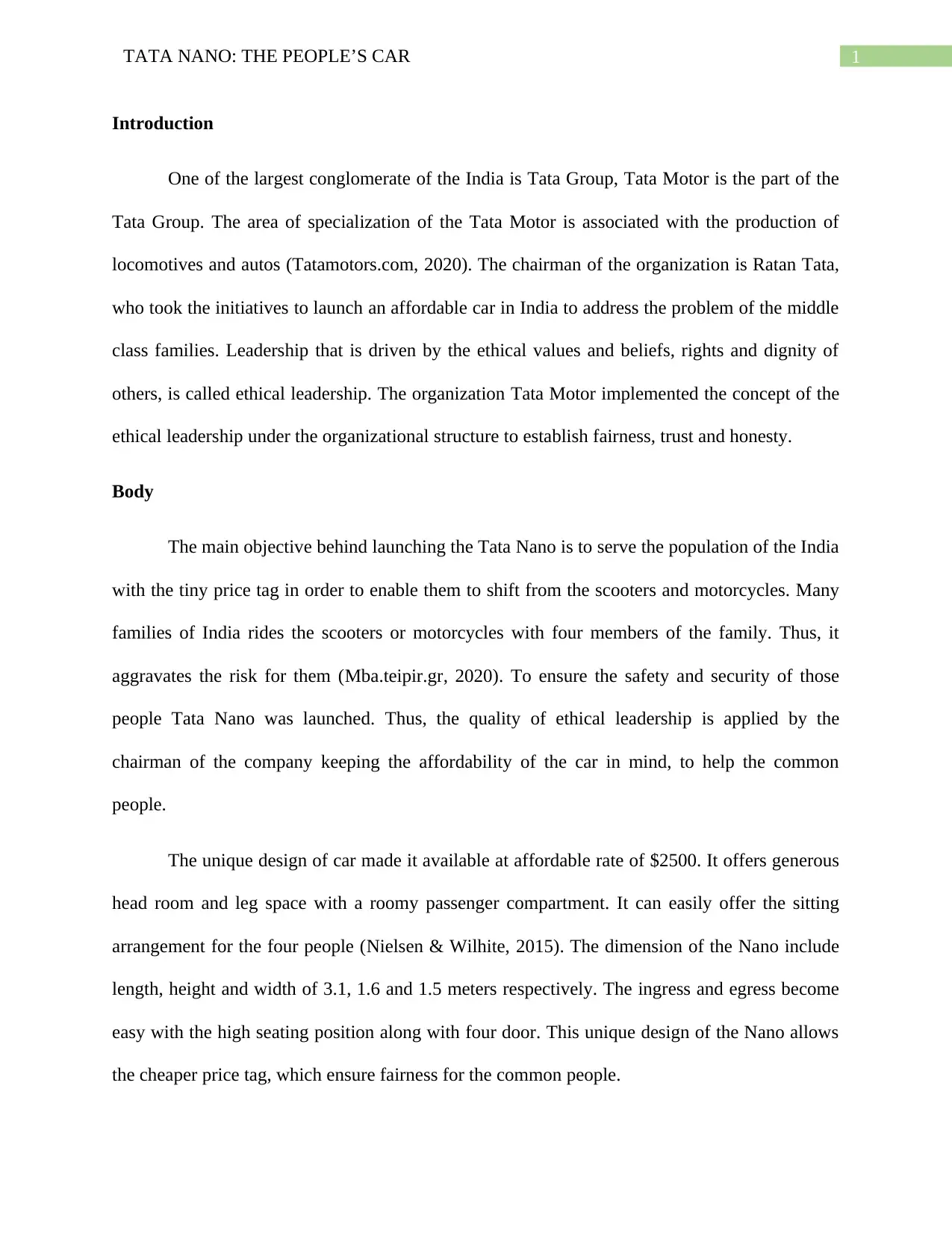
1TATA NANO: THE PEOPLE’S CAR
Introduction
One of the largest conglomerate of the India is Tata Group, Tata Motor is the part of the
Tata Group. The area of specialization of the Tata Motor is associated with the production of
locomotives and autos (Tatamotors.com, 2020). The chairman of the organization is Ratan Tata,
who took the initiatives to launch an affordable car in India to address the problem of the middle
class families. Leadership that is driven by the ethical values and beliefs, rights and dignity of
others, is called ethical leadership. The organization Tata Motor implemented the concept of the
ethical leadership under the organizational structure to establish fairness, trust and honesty.
Body
The main objective behind launching the Tata Nano is to serve the population of the India
with the tiny price tag in order to enable them to shift from the scooters and motorcycles. Many
families of India rides the scooters or motorcycles with four members of the family. Thus, it
aggravates the risk for them (Mba.teipir.gr, 2020). To ensure the safety and security of those
people Tata Nano was launched. Thus, the quality of ethical leadership is applied by the
chairman of the company keeping the affordability of the car in mind, to help the common
people.
The unique design of car made it available at affordable rate of $2500. It offers generous
head room and leg space with a roomy passenger compartment. It can easily offer the sitting
arrangement for the four people (Nielsen & Wilhite, 2015). The dimension of the Nano include
length, height and width of 3.1, 1.6 and 1.5 meters respectively. The ingress and egress become
easy with the high seating position along with four door. This unique design of the Nano allows
the cheaper price tag, which ensure fairness for the common people.
Introduction
One of the largest conglomerate of the India is Tata Group, Tata Motor is the part of the
Tata Group. The area of specialization of the Tata Motor is associated with the production of
locomotives and autos (Tatamotors.com, 2020). The chairman of the organization is Ratan Tata,
who took the initiatives to launch an affordable car in India to address the problem of the middle
class families. Leadership that is driven by the ethical values and beliefs, rights and dignity of
others, is called ethical leadership. The organization Tata Motor implemented the concept of the
ethical leadership under the organizational structure to establish fairness, trust and honesty.
Body
The main objective behind launching the Tata Nano is to serve the population of the India
with the tiny price tag in order to enable them to shift from the scooters and motorcycles. Many
families of India rides the scooters or motorcycles with four members of the family. Thus, it
aggravates the risk for them (Mba.teipir.gr, 2020). To ensure the safety and security of those
people Tata Nano was launched. Thus, the quality of ethical leadership is applied by the
chairman of the company keeping the affordability of the car in mind, to help the common
people.
The unique design of car made it available at affordable rate of $2500. It offers generous
head room and leg space with a roomy passenger compartment. It can easily offer the sitting
arrangement for the four people (Nielsen & Wilhite, 2015). The dimension of the Nano include
length, height and width of 3.1, 1.6 and 1.5 meters respectively. The ingress and egress become
easy with the high seating position along with four door. This unique design of the Nano allows
the cheaper price tag, which ensure fairness for the common people.
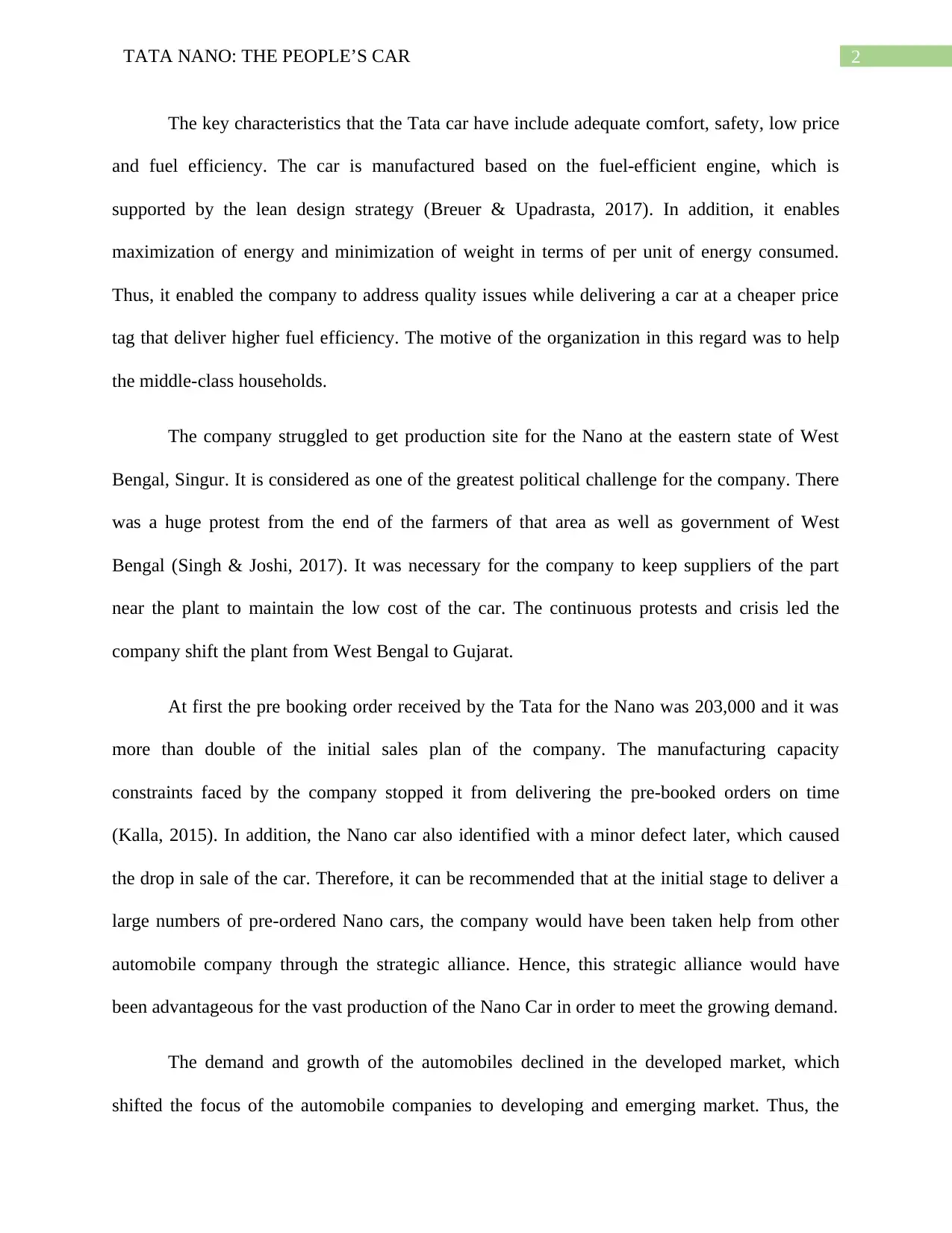
2TATA NANO: THE PEOPLE’S CAR
The key characteristics that the Tata car have include adequate comfort, safety, low price
and fuel efficiency. The car is manufactured based on the fuel-efficient engine, which is
supported by the lean design strategy (Breuer & Upadrasta, 2017). In addition, it enables
maximization of energy and minimization of weight in terms of per unit of energy consumed.
Thus, it enabled the company to address quality issues while delivering a car at a cheaper price
tag that deliver higher fuel efficiency. The motive of the organization in this regard was to help
the middle-class households.
The company struggled to get production site for the Nano at the eastern state of West
Bengal, Singur. It is considered as one of the greatest political challenge for the company. There
was a huge protest from the end of the farmers of that area as well as government of West
Bengal (Singh & Joshi, 2017). It was necessary for the company to keep suppliers of the part
near the plant to maintain the low cost of the car. The continuous protests and crisis led the
company shift the plant from West Bengal to Gujarat.
At first the pre booking order received by the Tata for the Nano was 203,000 and it was
more than double of the initial sales plan of the company. The manufacturing capacity
constraints faced by the company stopped it from delivering the pre-booked orders on time
(Kalla, 2015). In addition, the Nano car also identified with a minor defect later, which caused
the drop in sale of the car. Therefore, it can be recommended that at the initial stage to deliver a
large numbers of pre-ordered Nano cars, the company would have been taken help from other
automobile company through the strategic alliance. Hence, this strategic alliance would have
been advantageous for the vast production of the Nano Car in order to meet the growing demand.
The demand and growth of the automobiles declined in the developed market, which
shifted the focus of the automobile companies to developing and emerging market. Thus, the
The key characteristics that the Tata car have include adequate comfort, safety, low price
and fuel efficiency. The car is manufactured based on the fuel-efficient engine, which is
supported by the lean design strategy (Breuer & Upadrasta, 2017). In addition, it enables
maximization of energy and minimization of weight in terms of per unit of energy consumed.
Thus, it enabled the company to address quality issues while delivering a car at a cheaper price
tag that deliver higher fuel efficiency. The motive of the organization in this regard was to help
the middle-class households.
The company struggled to get production site for the Nano at the eastern state of West
Bengal, Singur. It is considered as one of the greatest political challenge for the company. There
was a huge protest from the end of the farmers of that area as well as government of West
Bengal (Singh & Joshi, 2017). It was necessary for the company to keep suppliers of the part
near the plant to maintain the low cost of the car. The continuous protests and crisis led the
company shift the plant from West Bengal to Gujarat.
At first the pre booking order received by the Tata for the Nano was 203,000 and it was
more than double of the initial sales plan of the company. The manufacturing capacity
constraints faced by the company stopped it from delivering the pre-booked orders on time
(Kalla, 2015). In addition, the Nano car also identified with a minor defect later, which caused
the drop in sale of the car. Therefore, it can be recommended that at the initial stage to deliver a
large numbers of pre-ordered Nano cars, the company would have been taken help from other
automobile company through the strategic alliance. Hence, this strategic alliance would have
been advantageous for the vast production of the Nano Car in order to meet the growing demand.
The demand and growth of the automobiles declined in the developed market, which
shifted the focus of the automobile companies to developing and emerging market. Thus, the
⊘ This is a preview!⊘
Do you want full access?
Subscribe today to unlock all pages.

Trusted by 1+ million students worldwide
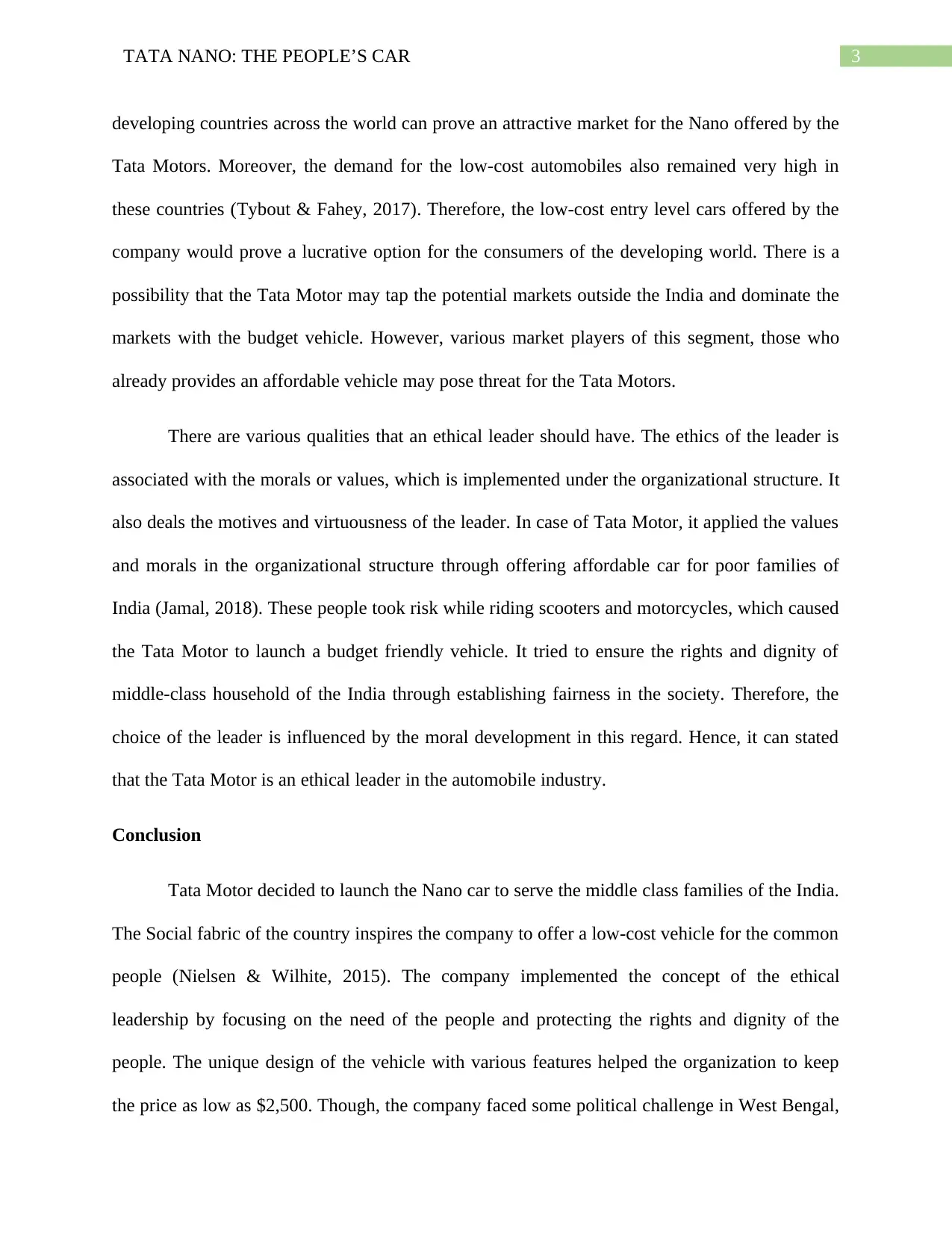
3TATA NANO: THE PEOPLE’S CAR
developing countries across the world can prove an attractive market for the Nano offered by the
Tata Motors. Moreover, the demand for the low-cost automobiles also remained very high in
these countries (Tybout & Fahey, 2017). Therefore, the low-cost entry level cars offered by the
company would prove a lucrative option for the consumers of the developing world. There is a
possibility that the Tata Motor may tap the potential markets outside the India and dominate the
markets with the budget vehicle. However, various market players of this segment, those who
already provides an affordable vehicle may pose threat for the Tata Motors.
There are various qualities that an ethical leader should have. The ethics of the leader is
associated with the morals or values, which is implemented under the organizational structure. It
also deals the motives and virtuousness of the leader. In case of Tata Motor, it applied the values
and morals in the organizational structure through offering affordable car for poor families of
India (Jamal, 2018). These people took risk while riding scooters and motorcycles, which caused
the Tata Motor to launch a budget friendly vehicle. It tried to ensure the rights and dignity of
middle-class household of the India through establishing fairness in the society. Therefore, the
choice of the leader is influenced by the moral development in this regard. Hence, it can stated
that the Tata Motor is an ethical leader in the automobile industry.
Conclusion
Tata Motor decided to launch the Nano car to serve the middle class families of the India.
The Social fabric of the country inspires the company to offer a low-cost vehicle for the common
people (Nielsen & Wilhite, 2015). The company implemented the concept of the ethical
leadership by focusing on the need of the people and protecting the rights and dignity of the
people. The unique design of the vehicle with various features helped the organization to keep
the price as low as $2,500. Though, the company faced some political challenge in West Bengal,
developing countries across the world can prove an attractive market for the Nano offered by the
Tata Motors. Moreover, the demand for the low-cost automobiles also remained very high in
these countries (Tybout & Fahey, 2017). Therefore, the low-cost entry level cars offered by the
company would prove a lucrative option for the consumers of the developing world. There is a
possibility that the Tata Motor may tap the potential markets outside the India and dominate the
markets with the budget vehicle. However, various market players of this segment, those who
already provides an affordable vehicle may pose threat for the Tata Motors.
There are various qualities that an ethical leader should have. The ethics of the leader is
associated with the morals or values, which is implemented under the organizational structure. It
also deals the motives and virtuousness of the leader. In case of Tata Motor, it applied the values
and morals in the organizational structure through offering affordable car for poor families of
India (Jamal, 2018). These people took risk while riding scooters and motorcycles, which caused
the Tata Motor to launch a budget friendly vehicle. It tried to ensure the rights and dignity of
middle-class household of the India through establishing fairness in the society. Therefore, the
choice of the leader is influenced by the moral development in this regard. Hence, it can stated
that the Tata Motor is an ethical leader in the automobile industry.
Conclusion
Tata Motor decided to launch the Nano car to serve the middle class families of the India.
The Social fabric of the country inspires the company to offer a low-cost vehicle for the common
people (Nielsen & Wilhite, 2015). The company implemented the concept of the ethical
leadership by focusing on the need of the people and protecting the rights and dignity of the
people. The unique design of the vehicle with various features helped the organization to keep
the price as low as $2,500. Though, the company faced some political challenge in West Bengal,
Paraphrase This Document
Need a fresh take? Get an instant paraphrase of this document with our AI Paraphraser

4TATA NANO: THE PEOPLE’S CAR
it was able to set up the manufacturing unit in Gujarat. The company may plan to spread business
in other emerging countries outside India, which will prove beneficial.
it was able to set up the manufacturing unit in Gujarat. The company may plan to spread business
in other emerging countries outside India, which will prove beneficial.
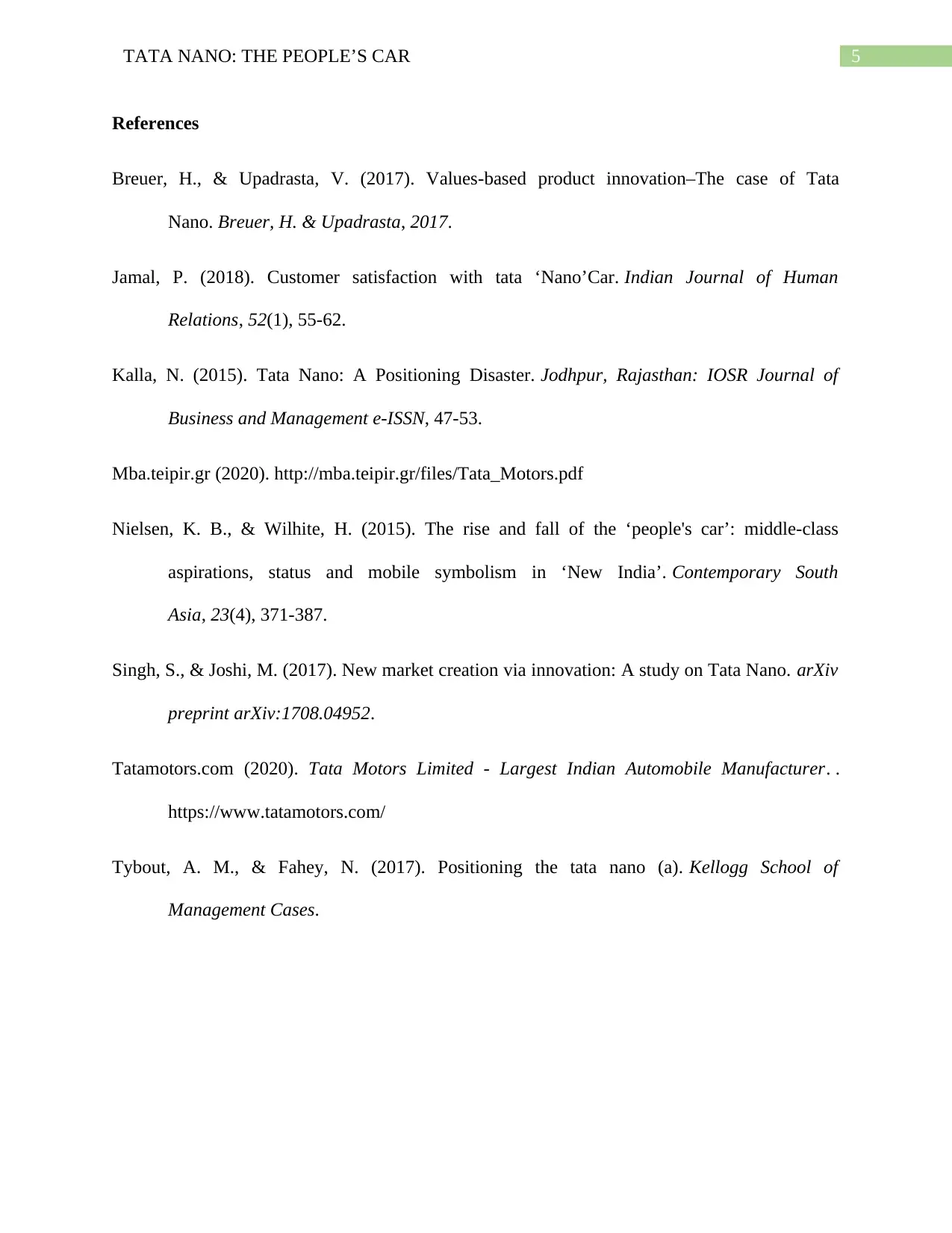
5TATA NANO: THE PEOPLE’S CAR
References
Breuer, H., & Upadrasta, V. (2017). Values-based product innovation–The case of Tata
Nano. Breuer, H. & Upadrasta, 2017.
Jamal, P. (2018). Customer satisfaction with tata ‘Nano’Car. Indian Journal of Human
Relations, 52(1), 55-62.
Kalla, N. (2015). Tata Nano: A Positioning Disaster. Jodhpur, Rajasthan: IOSR Journal of
Business and Management e-ISSN, 47-53.
Mba.teipir.gr (2020). http://mba.teipir.gr/files/Tata_Motors.pdf
Nielsen, K. B., & Wilhite, H. (2015). The rise and fall of the ‘people's car’: middle-class
aspirations, status and mobile symbolism in ‘New India’. Contemporary South
Asia, 23(4), 371-387.
Singh, S., & Joshi, M. (2017). New market creation via innovation: A study on Tata Nano. arXiv
preprint arXiv:1708.04952.
Tatamotors.com (2020). Tata Motors Limited - Largest Indian Automobile Manufacturer. .
https://www.tatamotors.com/
Tybout, A. M., & Fahey, N. (2017). Positioning the tata nano (a). Kellogg School of
Management Cases.
References
Breuer, H., & Upadrasta, V. (2017). Values-based product innovation–The case of Tata
Nano. Breuer, H. & Upadrasta, 2017.
Jamal, P. (2018). Customer satisfaction with tata ‘Nano’Car. Indian Journal of Human
Relations, 52(1), 55-62.
Kalla, N. (2015). Tata Nano: A Positioning Disaster. Jodhpur, Rajasthan: IOSR Journal of
Business and Management e-ISSN, 47-53.
Mba.teipir.gr (2020). http://mba.teipir.gr/files/Tata_Motors.pdf
Nielsen, K. B., & Wilhite, H. (2015). The rise and fall of the ‘people's car’: middle-class
aspirations, status and mobile symbolism in ‘New India’. Contemporary South
Asia, 23(4), 371-387.
Singh, S., & Joshi, M. (2017). New market creation via innovation: A study on Tata Nano. arXiv
preprint arXiv:1708.04952.
Tatamotors.com (2020). Tata Motors Limited - Largest Indian Automobile Manufacturer. .
https://www.tatamotors.com/
Tybout, A. M., & Fahey, N. (2017). Positioning the tata nano (a). Kellogg School of
Management Cases.
⊘ This is a preview!⊘
Do you want full access?
Subscribe today to unlock all pages.

Trusted by 1+ million students worldwide
1 out of 6
Related Documents
Your All-in-One AI-Powered Toolkit for Academic Success.
+13062052269
info@desklib.com
Available 24*7 on WhatsApp / Email
![[object Object]](/_next/static/media/star-bottom.7253800d.svg)
Unlock your academic potential
Copyright © 2020–2025 A2Z Services. All Rights Reserved. Developed and managed by ZUCOL.



